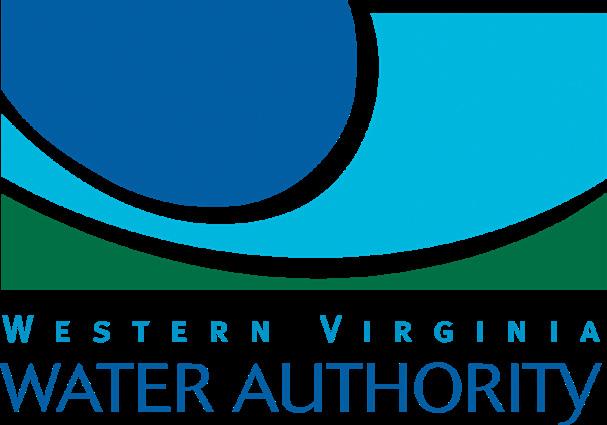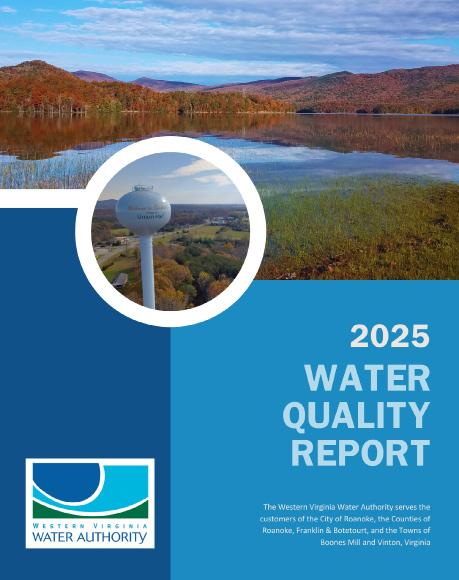

WESTERN VIRGINIA WATER AUTHORITY
ABOUT THIS REPORT
The Western Virginia Water Authority supplies customers in the City of Roanoke, the Counties of Roanoke, Franklin and Botetourt and the Towns of Boones Mill and Vinton, VA with an annual water quality report. This provides you with information about the source of your water, what it contains and how it compares to the standards set by regulatory agencies based on data collected during calendar year 2024 or the most recent testing period.
On July 1, 2004 the Western Virginia Water Authority was formed from the former utility departments of the City of Roanoke and Roanoke County. In November 2009 Franklin County joined the Water Authority, and Botetourt County joined in 2015 offering a larger regional approach to meeting the communities’ water and wastewater needs. The Town of Boones Mill started receiving service from the Water Authority in 2021, and the Town of Vinton utility system was acquired in 2022. In 2024, the Authority began operations of the Ferrum Sewer & Water Authority.
OUR EXECUTIVE DIRECTOR
Michael McEvoy, the Western Virginia Water Authority’s Executive Director, oversees a dedicated team of professionals who enhance the well-being and quality of life for our regional community through the treatment and delivery of 19-million gallons of drinking water and collection and treatment of 32-million gallons of wastewater each day.
Over our 20-years of operation, the Authority has earned the highest industry awards for both water and wastewater, implemented energy saving measures across all departments, and rehabilitated aging water distribution and sewer collection pipes. Water is treated from surface water and groundwater sources located across the service area.
BOARD OF DIRECTORS
The Western Virginia Water Authority’s Board of Directors, appointed by the member localities, governs the Authority. Representatives from the City of Roanoke include Mr. Harvey Brookins, Mr. Mike Loveman and Ms. Valmarie Turner. The Roanoke County representatives include Mr. Don Halliwill, Mr. Richard Caywood and Mr. Randall Hancock. Mrs. Shirley Holland represents Franklin County, and Mr. Hunter Young represents Botetourt County.
Board meetings are held on the third Thursday of each month (with the exception of August and December) at 601 S. Jefferson Street. The Board meetings are open to the public, and meeting minutes and information is available on our website at www.westernvawater.org.



Setting Standards for Your Water
In order to ensure that tap water is safe to drink, the Environmental Protection Agency (EPA) prescribes regulations which limit the amount of certain contaminants in water provided by public water systems. That informaton is provided in the data charts on pages for 7 - 43 for each water system.
Food and Drug Administration regulations establish limits for contaminants in bottled water which must provide the same protection for public health. All drinking water, including bottled drinking water, may reasonably be expected to contain at least small amounts of some contaminants. The presence of contaminants does not necessarily indicate that water poses a health risk.
The U.S. Environmental Protection Agency (EPA) sets maximum contaminant levels (MCLs) at very stringent levels. In developing the standards, EPA assumes that the average adult drinks 2 liters of water each day throughout a 70-year life span. EPA generally sets MCLs at levels that will result in no adverse health effects for some contaminants or a one-in-ten-thousand to one-in-one-million chance of having the described health effect for other contaminants.
Cryptosporidium and Giardia
Cryptosporidium and Giardia
Cryptosporidium and Giardia are microscopic organisms that can cause fever, diarrhea and other gastrointestinal symptoms when ingested. The organisms come from animal and human wastes and are eliminated through water filtration and disinfection. Even though the presence of these organisms is not regulated by the state or federal government, the Water Authority has tested for these organisms.
Some people may be more vulnerable to contaminants in drinking water than the general population. Immuno-compromised persons, such as persons with cancer undergoing chemotherapy, persons
The tables of data on pages 7 - 43 summarize water-testing results from 2024 or the most recent reporting year for both regulated and non-regulated substances. Many other primary and secondary contaminants have been analyzed but were either below the instrument’s detection limits or below the MCLs.
There is no State or Federal MCL for sodium. Monitoring is required to provide information to consumers and health officials that are concerned about sodium intake due to dietary restrictions. The EPA recommended optimal level of sodium is less than 20 ppm, established for people on a “strict” sodium intake diet. The amount of sodium detected in each water system is listed in the data charts.
The Western Virginia Water Authority constantly monitors its water supplies for various contaminants to meet all regulatory requirements. All regulated substances must be tested annually (or triennially for small systems) except for lead and copper and SOCs, which must be tested every three years, and radiologicals, which must be tested every six to nine years. The TTHMs/HAA5s were derived from running annual averages.
who have undergone organ transplants, people with HIV/AIDS or other immune system disorders, some elderly, and infants can be particularly at risk from infections. These people should seek advice about drinking water from their health care providers. EPA/ CDC guidelines on appropriate means to lessen the risk of infection by Cryptosporidium and other microbiological contaminants are available from the Safe Drinking Water Hotline (800-426-4791).
Water Hardness Discolored Water
Changes in water pressure in water systems, such as when water mains break or fire hydrants are used or flushed, can occasionally cause drinking water to be discolored. The discoloration is caused by sediments in pipes mixing with clear water. The sediments occur naturally from the oxidation of iron in pipes.
While discolored water is ordinarily safe to drink, it is best to flush any discolored water from pipes by turning on all cold-water faucets in your home or business. Avoid turning on hot-water faucets so the discolored water is not drawn into water heaters.
If you notice evidence of a water main break or leaking fire hydrant, please call 540.853.5700.
As water naturally flows over rocks and through the soil, it picks up minerals. The more calcium and magnesium present, the harder your water. While water hardness is not a safety issue, you may notice increased mineral build-up or soap residue with harder water. Hardness can be expressed as PPM - parts per million or GPG - grains per gallon.
Terms Used in This Water Quality Report
Action Level (AL): The concentration of a contaminant that triggers treatment or other requirement that a water system must follow.
Combined Radium: Radium 226 + Radium 228
E. coli: Bacteria from human and animal fecal waste
HAA5s: Haloacetic acids.
LRAA: Locational Running Annual Average
Maximum Contaminant Level (MCL):
The highest level of a contaminant that is allowed in drinking water. MCLs are set as close to the MCLG as feasible using the best available treatment technology.
Maximum Contaminant Level Goal (MCLG): The level of a contaminant in drinking water below which there is no known or expected risk to health. MCLGs allow for a margin of safety.
Maximum Residual Disinfection Level (MRDL): The highest level of a disinfection allowed in drinking water. There is convincing evidence that addition of a disinfectant is necessary for control of microbial contaminants.
mg/L: Milligrams per liter, also referred to as parts per million (for example, one minute in two years).
ND: Analyte was not detected or was below the method detection limit of the laboratory’s instrumentation.
NTUs: Nephelometric Turbidity Units; a measure of turbidity.
P/A: Present or Absent
pCi/L: Picocuries per liter is a measure of the radioactivity in water.
ppm: One part per million, also referred to as mg/L, (for example, one minute in two years).
ppb: One part per billion, also referred to as μg/L (for example, one minute in 2,000 years).
ppt: One part per trillion, also referred to as ng/L (for example, one second in nearly 32,000 years).
TTHMs: Total Trihalomethanes
Treatment Technique (TT): A required process intended to reduce the level of a contaminant in drinking water.
μg/L: Micrograms per liter, also referred to as parts per billion (for example, one minute in 2,000 years).
μmhos/cm: Micromhos per centimeter; a measure of conductivity.
Substance Source of Substance
Alkalinity
Antimony
Arsenic
Barium
Beryllium
Cadmium
Chlorate
Chlorine
Chlorite
Chromium
Conductivity
Measurement of naturally occurring carbonates
Discharge from petroleum refineries; fire retardants; ceramics; electronics; solder
Erosion of natural deposits; runoff from orchards, runoff from glass and electronics production wastes
Discharge from drilling wastes; discharge from metal refineries; erosion of natural deposits
Discharge from metal refineries and coal-burning factories; discharge from electrical, aerospace, and defense industries
Corrosion of galvanized pipes; erosion of natural deposits; discharge from metal refineries; runoff from waste batteries and paints
By-product of treating drinking water with chlorine dioxide
Required disinfectant added during treatment process to eliminate bacteria
By-product of treating drinking water with chlorine dioxide
Discharge from steel and pulp mills; erosion of natural deposits
Physical property of water
Copper Natural\industrial deposits, plumbing, wood preservatives
Corrosivity
Ethylbenzene
Fecal Coliforms
Fluoride
Physical property of water that occurs when water reacts with metal
Discharge from petroleum refineries
Human and animal waste
Erosion of natural deposits; water additive which promotes strong teeth; discharge from aluminum and fertilizer factories
Gross Alpha Erosion of natural deposits
Gross Beta Decay of natural and man-made deposits
HAA5s
Hardness
HFPO-DA
By-product of drinking water chlorination
Measurement of naturally occurring hardness metals
Hexafluoropropylene oxide-dimer acid; an industrial replacement for the straight-chain perfluorooctanoic acid (PFOA). Also called GenX.
Iron Naturally occurring in the environment
Lead Natural\industrial deposits, plumbing solder, brass alloy in faucets
Manganese Naturally occurring in the environment
Orthophosphate (as P) Corrosion inhibitor added during treatment process
PFOA
Radium 226/228
Perfluorooctanoic acid is a man-made chemical used to make everyday products we use resist heat, oil, stains, grease, and water.
Erosion of natural deposits
Selenium Discharge from petroleum refineries; erosion of natural deposits; discharge from mines
Sodium Naturally occurring in the environment
Styrene Discharge from rubber and plastic factories; leaching from landfills
Thallium
Toluene
Leaching from ore-processing sites; discharge from electronics, glass, and drug factories
Discharge from petroleum factories
Total Coliforms Naturally present in the environment
Total Nitrate & Nitrite (as N)
TTHMs
Vinyl Chloride
Run-off from fertilizer use; leaching from septic tanks, sewage; erosion of natural deposits
By-product of drinking water chlorination
Leaching from PVC pipes; discharge from plastic factories
Xylene Discharge from petroleum factories; discharge from chemical factory
Zinc Naturally occurring in the environment
1,2-dichlorobenzene Discharge from industrial chemical factories
1,2,4-trichlorobenzene
Discharge from textile finishing factories
Lead and Copper Testing
Quality water begins at the source. It is important that the Western Virginia Water Authority (Authority) knows and understands the water chemistry from each source, closely monitors the treatment process and understands the pipe material that the water can flow through. This is especially important regarding lead and copper.
Copper is a nutritionally essential element, but at high levels, copper can cause gastrointestinal difficulties such as nausea and diarrhea. Lead can cause serious health problems, especially for pregnant women and young children. Exposure to lead in drinking water can cause serious health effects in all age groups. Infants and children can have decreases in IQ and attention span. Lead exposure can lead to new learning and behavior problems or exacerbate existing learning and behavior problems. The children of women who are exposed to lead before or during pregnancy can have increased risk of these adverse health effects. Adults can have increased risks of heart disease, high blood pressure, kidney or nervous system problems.
Lead in drinking water is primarily from materials and components associated with service lines and home plumbing. The Western Virginia Water Authority is responsible for providing high quality drinking water and removing lead pipes, but cannot control the variety of materials used in plumbing components in your home. You share the responsibility for protecting yourself and your family from the lead in your home plumbing. You can take responsibility by
identifying and removing lead materials within your home plumbing and taking steps to reduce your family’s risk. Before drinking tap water, flush your pipes for several minutes by running your tap, taking a shower, doing laundry or a load of dishes. You can also use a filter certified by an American National Standards Institute accredited certifier to reduce lead in drinking water. If you are concerned about lead in your water and wish to have your water tested, contact the Authority at 540.853.5700. Information on lead in drinking water, testing methods, and steps you can take to minimize exposure is available at http://www.epa.gov/safewater/lead
The Authority maintains over 1,300 miles of pipes up to and including the lines going to the customer’s water meter. Pipe materials in our system can be cast iron, ductile iron or pvc. We do not know of any lead pipes in our distribution system. However, customers, particularly those in older homes, may have lead plumbing in their homes or pipes that were joined with lead solder.
We treat the water with corrosion control or adjust the pH of the water so that pipes in our distribution system and the customers’ pipes in their homes are protected.
Information on lead in drinking water, testing methods and steps you can take to minimize exposure is available from the Safe Drinking Water Hotline or at http://www.epa.gov/safewater/lead
What is Your Service Line Pipe Material?
The Water Authority has developed an inventory of service line pipe material used in our public distribution system and in the customer’s pipe from the meter to the home. This is a requirement of the Environmental Protection Agency’s Lead and Copper Rule Revision. You can view the Water Service Line Lead Status dashboard at www. westernvawater.org/gis
While no lead lines have been found on the public side, we need your help identifying what type of pipe material is coming into your home.
Water service line pipes can consist of many different materials including lead, galvanized iron, brass, copper or plastic. Use this information or scan the QR code below to watch our video tutorial to help you determine your water service line material and/or plumbing material.

We’re asking customers to enter their water service line pipe material on our reporting form so we can add it to the Authority’s GIS mapping and inventory.
For properties where the inventory has already been obtained, you will see the type of pipe material that comes from the public water line to your meter and any information we have on the private water line that comes from the meter to your home.


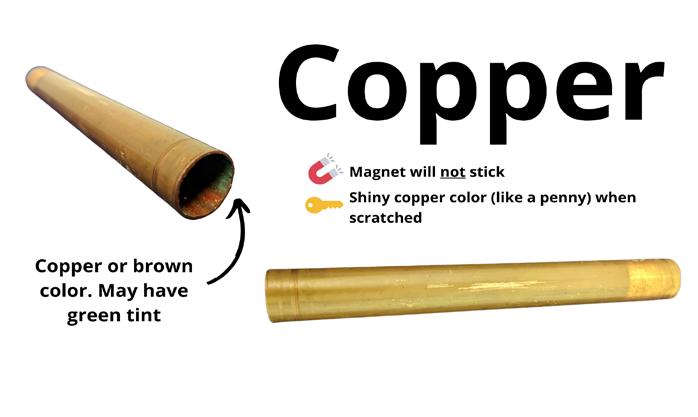

Unregulated Contaminant Monitoring - UCMR5
The following substances were tested in Western Virginia Water Authority sources during calendar year 2023-24 as part of the unregulated contaminants monitoring. Unregulated contaminants are those for which EPA has not established drinking water standards. The unit of measurement for all data is ng/L.
Unregulated contaminant monitoring helps EPA to determine where certain contaminants occur and whether the Agency should consider regulating those contaminants in the future.
Spring Hollow was tested four times in this monitoring period - 9/11/23, 12/13/23, 3/28,23, and 6/11/24. The only detections were 9/11/23.
Crystal Spring was tested five times in this monitoring period - 9/11/23, 12/13/23, 3/29/,24, 4/3/24 and 6/11/24. There were no detections.
Muse Spring Treatment Plant was tested four times in this monitoring period9/11/23, 12/13/23, 3/28/,24, 6/11/24 and 6/11/24. One detection was made on 3/28/24.
Source Water Assessment
As water travels over the surface of the land or through the ground, it dissolves naturally occurring minerals and can pick up substances resulting from the presence of animals or from human activity. Water from surface sources is treated to make it drinkable while groundwater may or may not require any treatment.
Contaminants in source water may be naturally occurring substances, or may come from:
• Microbial contaminants, such as viruses and bacteria, which may come from sewage treatment plants, septic systems, agricultural livestock operations, and wildlife;
• Inorganic contaminants, such as salts and metals, which can be naturally-occurring or result from urban stormwater runoff, industrial or domestic wastewater discharges, oil and gas production, mining, or farming;
• Pesticides and herbicides, which may come from a variety of sources such as agriculture, urban stormwater runoff, and residential uses;
• Organic chemical contaminants, including synthetic and volatile organic chemicals, which are by-products of industrial processes and petroleum production, and can also come from gas stations, urban stormwater runoff, and septic systems; and
• Radioactive contaminants, which can be naturallyoccurring or be the result of oil and gas production and mining activities.
The Western Virginia Water Authority has worked with the Virginia Department of Health to determine our water sources susceptibility to contaminants. The assessment is a requirement of the Virginia Department of Health’s (VDH) Source Water Assessment Program (SWAP) in accordance with the 1996 Amendments of the Safe Drinking Water Act.
The assessment determined that Crystal Spring, Muse Spring and Carvins Cove are susceptible to contamination based on land use activities and potential types of contaminants in these areas. This designation does not mean that the source water has been impacted or that it will be impacted. It does mean that if there is a release of pollutants in the assessment area, the source water could be impacted.
The VDH also completed a source water assessment of Spring Hollow Reservoir’s water source, the Roanoke River. This assessment determined that the Roanoke River may be susceptible to contamination because it is surface water exposed to a wide array of contaminants at varying concentrations. Also, changing hydrologic, hydraulic and atmospheric conditions promote migration of contaminants from land use activities of concern.
The assessment also determined that the Water Authority’s wells might be susceptible to contamination because they are located in areas that promote migration of contaminants from land use activities of concern. More specific information about these reports may be obtained by contacting the Western Virginia Water Authority’s Water Quality Division at 540.853.5700.
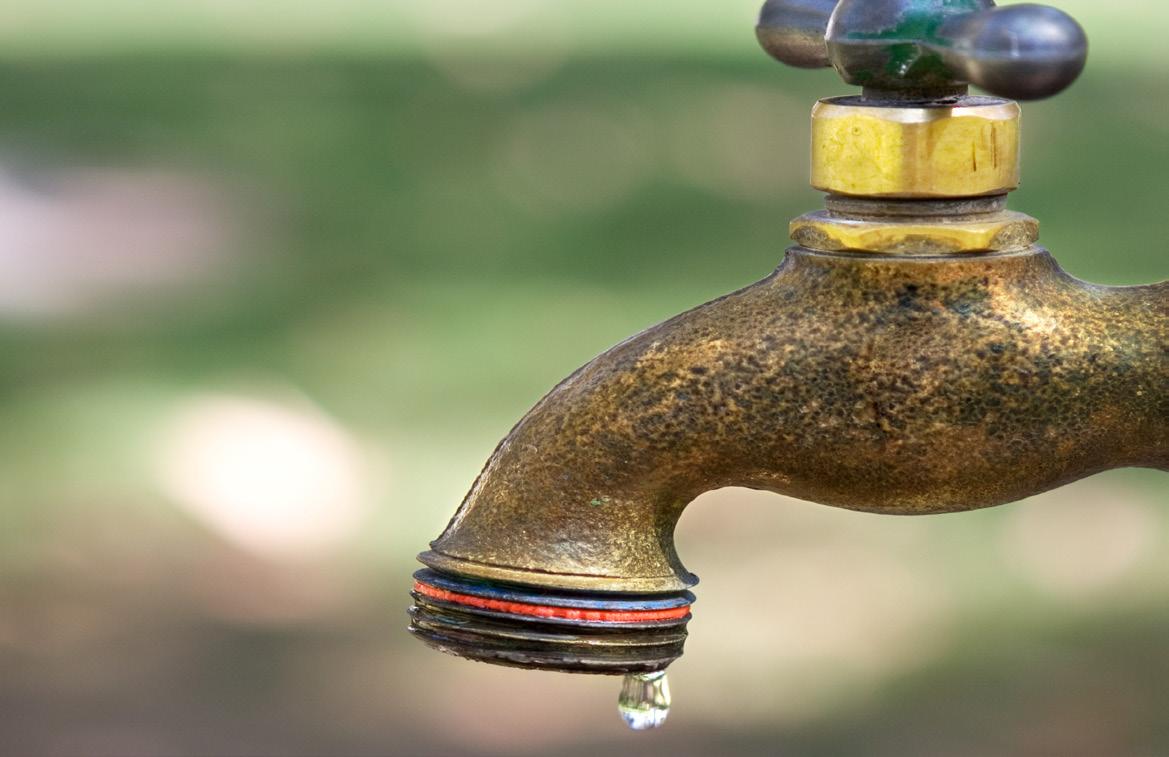
Backflow Prevention & Cross-Connection Identification
A plumbing cross-connection is an actual or potential connection between the public water supply and any source of contamination or pollutant. Without proper plumbing precautions, contaminated substances could backflow into the public system and your drinking water supply through this connection.
Water travelling through the Authority’s distribution system is pressurized. If the water system loses pressure, such as during a water main break, system maintenance or fire hydrant usage/testing, the flow of the water may be reversed. If a customer has made a cross-connection with hazardous substances or even non potable water, these substances can backflow into the public water system and create a risk to public health.
What You Can Do To Protect Your Drinking Water
Help us identify potential locations where backflow can occur.
Remove any cross-connections you find or install backflow prevention devices (available at hardware stores) where needed. A Water Authority representative is available to assist you with this process if needed.
If you have a backflow prevention device installed by a certified plumber, have it tested annually or after any repairs.
Questions about backflow prevention? Email us at backflow@westernvawater.org Call us at 540.853.5700
Use Your Water Wisely
Using water wisely in times of drought is critical; however, it is always important to use our natural resource wisely.
SHOWERS
Shorten your shower to 5 minutes and save up to 25 gallons of water.
LEAKS
Fix a leaky faucet and save up to 140 gallons of water a week.
WATERING YOUR LAWN
Put an empty tuna can on the lawn to catch and measure the output of your sprinkler. When the can is full, it’s time to turn off the sprinkler.
LAWN CARE
Water your garden or lawn before 10 AM or after 7 PM when temperatures are cooler to minimize evaporation.

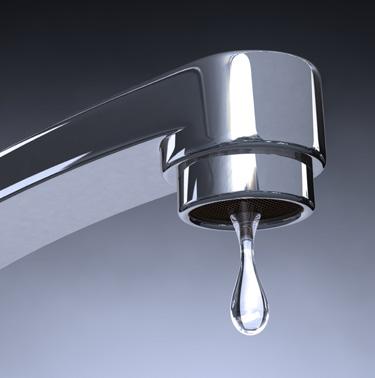


BRUSHING YOUR TEETH
Turn off the water while you brush your teeth and save 2 gallons of water.
LAUNDRY & DISHES
Use full loads in your washing machine and dishwasher to maximize efficiency.
WATERING PLANTS
Use old water from your dog’s bowl, leftover water from rinsing vegetables or the warm-up water from your shower to water plants.
CAR WASHING
Instead of washing your car at home, take it to a commercial car wash that recycles its water.
How to Check for a Toilet Leak
Toilets are the number one source of water leaks inside the home so this is the best place to start a leak detection. Because a toilet leak can waste up to 200 gallons of water per day, it is important to regularly test your toilets and quickly repair any leaks you discover.
To determine if a toilet is leaking, place some dye such as food coloring, Kool-Aid, cola or brewed coffee in the tank of the toilet before you go to bed. Do not flush or use the toilet during the test. If you see any of the color in the bowl of the toilet the next morning, then you know you have a leak that needs to be repaired.
If you discover that you have a toilet leak, make sure the lift chain is free of kinks and that you don’t have any mineral buildup around your valves that might prevent them from sealing properly. You can also use the adjustment screw on the overflow pipe to lower the water level in the tank to keep it from flowing into the overflow pipe. Most overflow pipes have a line on the pipe that indicates where the water level needs to be. If the flapper valve or plunger ball isn’t properly sealing at the bottom of the toilet, you will also get leaks. Parts are available at your local hardware store to replace these items.
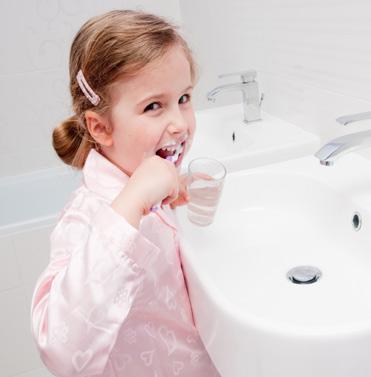
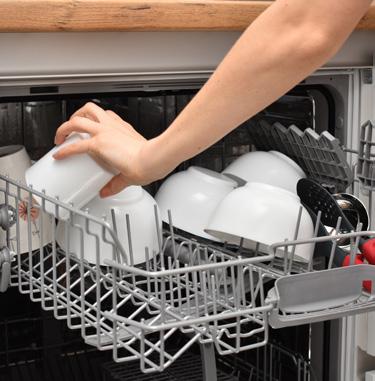



Drinking Water Systems in the Roanoke Valley
The Western Virginia Water Authority utilizes four surface water sources and multiple springs and wells as drinking water sources in the Roanoke Valley to serve customers in the City of Roanoke, the Counties of Roanoke, Franklin and Botetourt and the Towns of Boones Mill and Vinton. Having an abundant supply of water helps protect against drought or other emergencies.
Combined, the water treatment facilities for these sources can treat over 56-million gallons of water a day; however, current production averages about 19-million gallons per day.
Municipality Boundary
Water Source
Carvins Cove
Crystal Spring
Martin Creek Water System
Salem Source
Spring Hollow
Town of Vinton
Town of Boones Mill
Spring Hollow
MONTGOMERY COUNTY
ROANOKE COUNTY
Carvins Cove Reservoir & Treatment Facility

Carvins Cove Reservoir is situated within Carvins Cove Natural Reserve, a 12,672-acre watershed near Hollins University in Botetourt County. The land in the reserve above the 1,200-foot contour is owned and managed by the City of Roanoke. The land below this elevation, and the reservoir, are owned and operated by the Western Virginia Water Authority. In addition to receiving water from the watershed, the reservoir is fed from two underground tunnels that carry overflow from Tinker and Catawba Creeks. This surface water source covers 630 acres and stores 6.42-billion gallons of water at full pond.
How is it treated? Carvins Cove Water Treatment Facility has the capacity to treat 24-million gallons of water from the reservoir every day. Annual production averaged 9.48-million gallons per day. The water is first oxygenated and treated with sodium permanganate to oxidize dissolved organic matter, iron and manganese. Water is aerated to remove unwanted dissolved gases and to oxidize dissolved metals, which reduces any unpleasant tastes and odors. Flash mixing of chemicals is the next step, where ferric sulfate is added to coagulate suspended particles. Water then flows into settling basins where the particles clump together, become heavy and settle to the bottom of the basins. Next, the water is filtered through sand and anthracite and disinfected with chlorine. Fluoride is added to promote strong teeth. Sodium hydroxide is added to adjust the pH and reduce corrosivity, and orthophosphate is added to control corrosion in pipes.
Where does it serve? A large part of the northeastern and northwestern parts of the city, and the majority of the southeastern part of the city, to Reserve Avenue, are served by Carvins Cove. Portions of northern and northeastern Roanoke County are also served by the Carvins Cove water source. Water from Carvins Cove also serves the Botetourt area around Exit 150 to Tinkerview and Greenfield.
The Water Authority has inventoried service line pipe material, and has not found any lead lines to date. You can view the Water Service Line Lead Status dashboard at www.westernvawater.org/gis
Many other primary and secondary contaminants have been analyzed but were either below the instrument’s detection limits or below the Maxium Contaminant Levels (MCLs). Data collected during calendar year 2024 or most recent testing period. Water treated at the Carvins Cove Treatment Facility meets all state and federal monitoring and reporting requirements.


Carvins Cove Natural Reserve
www.westernvawater.org/carvinscove
Carvins Cove Natural Reserve, the second largest municipal park in the United States, offers outdoor recreation opportunities on the water and in the almost 12,700-acre watershed including boating, horseback riding, fishing, hiking, paddleboarding. picnicing and nature viewing.
You can bring your own boat or rent kayaks and jon boats at the reservoir. A large picnic shelter is available for daily rentals. For details and reservations, please see www.westernvawater.org/ coveonline.
Visitors to the Natural Reserve in personal vehicles are charged $7 per vehicle for daily use or annual passes are available for $50. See www.westernvawater.org/carvinscove for fees and information regarding equestrian and personal boat trailers.
Payment drop boxes are located at the Bennett Springs, Hollins Trailhead and Timberview parking lots. Passes can also be purchased from the Boat Landing Office on Reservoir Road or on our website. For more information, call the Natural Reserve at 540.362.1757 or visit www.westernvawater.org/coveonline.

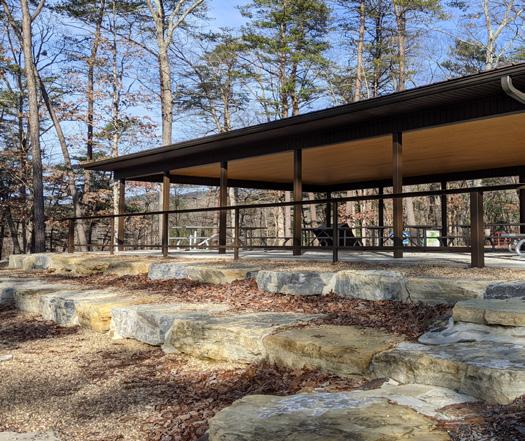
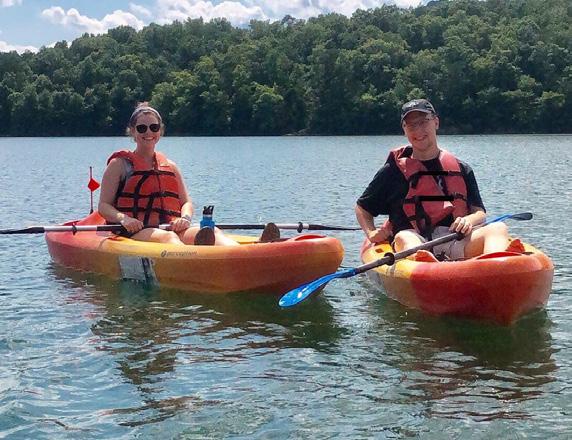

Lead and Copper Testing
and Disinfection By-Products
Carvins Cove Data
Crystal Spring Water Treatment Facility

Crystal Spring flows at the base of Mill Mountain in the southern part of the city. Annual production from this groundwater source is 4.24-million gallons of water a day.
How is it treated? The water is filtered in the Crystal Spring Ultrafiltration Treatment Facility which filters out all particles larger than 0.01 micron. One micron is one thousandth of a millimeter. Filtered water is treated with chlorine and fluoride and pumped to water customers from the Crystal Spring Pumping Station.
Where does it serve? Crystal Spring serves portions of southwest Roanoke County and the southwestern part of the city. The facility has the capacity to filter five-million gallons of water a day.
Tests for volatile organics (VOCs), pesticides and synthetic organic compounds (SOCs) have been conducted, and all were non-detect
Historic Snow Steam Pump at Crystal Spring
You are invited to tour the historic Crystal Spring Pump Station. From 1906 until 1959, when the steam powered pump was replaced with electric motors, the Snow Steam Pump pumped water from Crystal Spring into Roanoke’s water distribution system. Today, the Snow Steam Pump is listed on the National Register of Historic Places and is recognized as one of the last, best examples of its kind by the Smithsonian Institution.
Operating Hours
June-August
Saturdays Noon - 4pm
Sundays 1pm - 4pm
Admission is free | ADA accessible
Location
2012 S. Jefferson Street Roanoke, VA 24014
Located off I-581 at the intersection of Jefferson Street and McClanahan Avenue near Carilion Roanoke Memorial Hospital.
For More Information
Historical Society of Western Virginia 101 Shenandoah Avenue, NE, Roanoke, VA www.roanokehistory.org
540-982-5465
For information on group tours year-round Western Virginia Water Authority info@westernvawater.org 540-853-5700
(ND) thus meeting current state and federal standards for drinking water.
Many other primary and secondary contaminants have been analyzed but were either below the instrument’s detection limits or below the MCLs.
The Water Authority has inventoried service line pipe material, and has not found any lead lines to date. You can view the Water Service Line Lead Status dashboard at www.westernvawater.org/gis.
Crystal Spring data collected during calendar year 2024 or most recent testing period. Water treated at the Crystal Spring Treatment Facility meets all state and federal monitoring and reporting requirements.
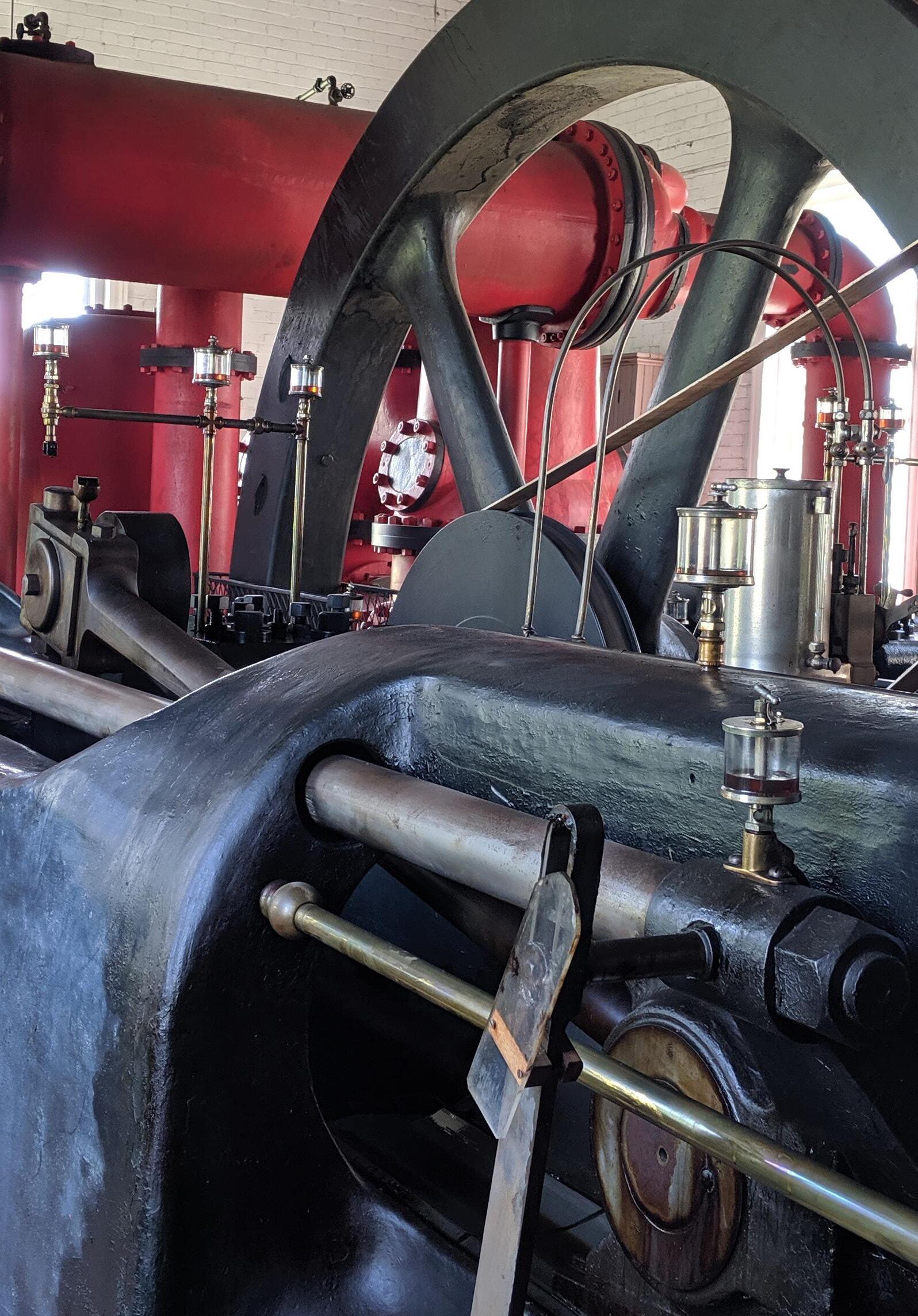
Disinfectants and Disinfection By-Products
Crystal Spring Data
Spring Hollow Water Treatment Facility

The water source for this system comes from the Roanoke River and is pumped into the Spring Hollow Reservoir, a 3.2-billion gallon sidestream storage reservoir.
How is it treated? Water is first oxygenated in the reservoir, then the water is withdrawn from the reservoir and treated with sodium hypochlorite and sodium permanganate to oxidize dissolved organic matter, iron and manganese. Treatment at the Spring Hollow Treatment Facility includes upflow clarification, filtration, chlorine disinfection and fluoridation. Orthophosphate is added to control corrosion in pipes. The Spring Hollow Water Treatment Facility currently has the capacity to treat 18-million gallons of water a day and can be expanded to 36-million gallons a day. Treated water is stored in a two-million gallon storage tank then pumped through the north and south transmission lines to the distribution system. Annual production averaged 3.42-million gallons a day. During an emergency, standby wells may be used to supplement the source water.
Where does it serve? Spring Hollow supplies water to various neighborhoods in Roanoke County and Franklin County through the southern transmission lines. The northern transmission lines run along I-81 and serve the City of Roanoke and Roanoke County.
Many other primary and secondary contaminants have been analyzed but were either below the instrument’s detection limits or below the MCLs.
The Water Authority has inventoried service line pipe material, and has not found any lead lines to date. You can view the Water Service Line Lead Status dashboard at www.westernvawater.org/gis.
Data collected during calendar year 2024 or most recent testing period. Water treated at the Spring Hollow Treatment Facility meets all state and federal monitoring and reporting requirements.
Learn About PFAS
PFAS are a group of over 6,000 man-made compounds used in various industries around the globe since the 1940s to make everyday products we use resist heat, oil, stains, grease, and water. They are extremely stable and do not breakdown in the environment.
The Western Virginia Water Authority (Authority) voluntarily tested for these substances as part of the unregulated contaminants monitoring program. Hexafluoropropylene oxide dimer acid (HFPO-DA), known more commonly by its trade name GenX, was detected at Spring Hollow. All other compounds were below the level of detection. At the time of this testing, there were no national or state advisories or
regulations for HFPO-DA. Testing continued as did research into the source of this substance.
On June 15, 2022, the EPA issued a lifetime health advisory for HFPO-DA of 10 parts per trillion (ppt) for the first time. For reference, if expressed as a unit of time, one part per trillion would be approximately one second in 32,000 years. On March 14, 2023 the EPA announced the proposed National Primary Drinking Water Regulation (NPDWR). This rule proposed that 10 parts per trillion would effectively become the maximum contaminant level for HFPO-DA. The proposed PFAS NPDWR did not require any actions until it became final. On April 10, 2024, the rule was finalized with the release of the final National Primary Drinking Water Regulation (NPDWR). In addition to establishing Maximum Contaminant Levels for several PFAS compounds, 10 parts per trillion was established as the maximum contaminant level for HFPO-DA, the compound detected at the Spring Hollow Reservoir. UCMR5 testing by the Virginia Department of Health in 2023 indicated detection of a second compound, PFOA, in the amount of 8.9 ppt. Weekly tests in 2024 have been non-detect for that compound in the Spring Hollow Reservoir and treated drinking water.
After the detection of HFPO-DA in the Spring Hollow Reservoir, the Authority increased the frequency of testing for this compound at Spring Hollow and adapted the use of granular activated carbon, considered the most viable treatment option for drinking water, as a treatment technique. The granular activated carbon is replaced every three months to provide optimal treatment to produce drinking water that is has HFPO-DA levels below 10 parts per trillion. The HFPO-DA detection level during calendar year 2024 from weekly testing was 0.615 ppt.
Pumping water from the Roanoke River was suspended from August 2022 to July 2023 to avoid introducing any more of the compound into the reservoir. The source of HFPO-DA in the Roanoke River, ProChem, Inc. in Elliston, Virginia stopped discharging water containing this compound and repeat tests determined that the river has remained non-detect for HFPO-DA since May 2023.
More information and current testing data is available at www.westernvawater.org/LearnAboutPFAS.
Lead and Copper Testing
and Disinfection By-Products
Subtances
Spring Hollow Data
Lead and Copper Testing
Muse Spring
The Muse Spring Water Treatment Facility, located on Riverland Road, treats raw water from Muse Spring and Garden City Well No. 3. This facility has the capacity to treat 2-million gallons per day. Annual production from this groundwater source was 1.09-million gallons of water a day.
How is it treated? The water is filtered in the Muse Spring Ultrafiltration Treatment Facility which filters out all particles larger than 0.01 micron. One micron is one thousandth of a millimeter. Filtered water is treated with chlorine, fluoride and orthophosphate and pumped to water customers from the Muse Spring Pumping Station.
Muse Spring Data
Where does it serve? Muse Spring ties directly into the existing Authority distribution system and will help serve the eastern portion of the Carvins Cove service area southeast of downtown
The Water Authority has inventoried service line pipe material, and has not found any lead lines to date. You can view the Water Service Line Lead Status dashboard at www.westernvawater.org/gis. Many other primary and secondary contaminants have been analyzed but were either below the instrument’s detection limits or below the MCLs. Data collected during calendar year 2024 or most recent testing period. Water treated at the Muse Spring
Facility meets all state and
and
and Disinfection By-Products
City of Salem
The Western Virginia Water Authority contracts with the City of Salem to purchase water to supply Robin Hood Park and other areas around West Main Street and Riverside Drive in Roanoke County. The City of Salem’s water source is the Roanoke River and three ground water wells. If you have any questions about this data, please contact the City of Salem Water Department at 375-3029. If you want to learn more about this source, please attend any of the regularly scheduled Salem City Council meetings. They are held on the second and fourth Monday of each month in council chambers. The City of Salem Water Department routinely monitors for contaminants in the drinking water mandated by Federal and State laws. The following table shows the results of monitoring for the period of
City of Salem Data
January 1st to December 31st, 2024 or the most recent monitoring period. The City of Salem Water Department had no violations during this time period. The Virginia Department of Health has completed a source water assessment for Salem’s waterworks system that provides information on possible sources of contamination to the source water. As determined by the source water assessment, the possibility of contamination to this water source (Roanoke River) is high. This is due to the fact that surface water is exposed to an inconsistent array of contaminants at varying concentrations due to changing hydrologic, hydraulic and atmospheric conditions with land use activities of concern in the assessment area. To view a copy of this water assessment, please contact the City of Salem Water Department office at 540-375-3029.
Blackwood Community Data
Martin Creek System
Seven wells supply this groundwater source, which is disinfected with chlorine prior to distribution. Water is distributed throughout the community by two storage tanks and distribution piping consisting of 8-inch, 6-inch and 4-inch pipe. The total source/ pump capacity is equal to 76,000 gallons per day. Current usage is approximately 26,000 gallons per day. Data presented is a (range) average of the wells in use.
This system supplies water to the Forest Edge and Carriage Hills areas.
According to results of the chemical analyses for Metals based on a sample collected in 2021-2022, the sodium in the
Blackwood System
PWSID# 2161046
The Blackwood Community drinking water is purchased from the City of Salem. The City of Salem has a water treatment plant that filters surface water from the Roanoke River and three ground water wells. The City of Salem chlorinates and fluoridates the water prior to distribution. (See page 19 for information on the City of Salem water.) Water is distributed throughout the Blackwood system by a storage tank and the distribution piping.
The Water Authority has inventoried service line pipe material, and has not found any lead lines to date. You can view the Water Service Line
treated water from well 1 had sodium of 40.5 ppm. This is above the EPA recommended optimal level of less than 20 mg/L for sodium in drinking water, which is established for those individuals on a “strict” sodium intake diet. The fluoride is naturally occurring and not from utility addition.
The Water Authority has inventoried service line pipe material, and has not found any lead lines to date. You can view the Water Service Line Lead Status dashboard at www.westernvawater.org/gis
Data collected during calendar year 2024 or most recent testing period.
Lead Status dashboard at www.
Data collected during calendar year 2024 or most recent testing period.
Substances
Wells located in the Town of Vinton
The Western Virginia Water Authority acquired the Town of Vinton utility system July 1, 2022. Customers in the downtown district receive a blend of water from the Craig Avenue well, Carvins Cove and Muse Spring. Other customers receive groundwater obtained from the wells noted in the chart above. Water is distributed throughout the system by booster stations, storage tanks, and distribution piping. Chlorination treatment is provided before the water enters the storage tanks.
The Water Authority has inventoried service line pipe material, and has not found any lead lines to date. You can view the Water Service Line Lead Status dashboard at www.westernvawater.org/gis.
The Western Virginia Water Authority is pleased to meet all requirements, and there were no drinking water violations in calendar year 2024. Data collected during calendar year 2024 or most recent testing period.
50 samples exceeded the Action Level (AL); 90th percentile = ND Range (ND - 10.2) samples exceeded the Action Level (AL); 90th percentile = 0.38 ppm Range (0.02 - 0.64)
Wells located in the Roanoke Area
The Authority maintains over 20 wells in the Roanoke area. While many of these wells are inactive, they can offer an additional supply of water if needed. Wells* represent those in service in 2024 including LaBellevue 7, and Starkey 3. Data presented as (range) average.
The Water Authority has inventoried service line pipe material, and has not found any lead lines to date. You can view the Water Service Line Lead Status dashboard at www. westernvawater.org/gis
The Western Virginia Water Authority is pleased to meet all requirements, and there were no drinking water violations in calendar year 2024. Data collected during calendar year 2024 or most recent testing period.
Botetourt County Water Systems

Water Main
Carvins Cove
Dal-Nita Hills
Eagle Rock
Glen Wilton
Griffith Park
Keswick Farms
North Botetourt
Walnut Manor
Reservoirs
Customers in Botetourt County receive treated water from Carvins Cove or from community wells.
The Western Virginia Water Authority is pleased to report that Botetourt well systems meet all requirements, and there were no drinking water violations in calendar year 2024. Data collected during calendar year 2024 or most recent testing period. The Water Authority has inventoried service line pipe material, and has not found any lead lines to date. You can view the Water Service Line Lead Status dashboard at www.westernvawater.org/gis.
Dal-Nita Hills | PWSID#
2023730
Water from Dal-Nita Hills well comes from a groundwater well and is distributed throughout the community by a storage tank and distribution piping. Chlorination treatment is provided. According to results of the chemical analyses for metals, the sodium in the treated water is 70 ppm. This is above the EPA recommended optimal level of less than 20 ppm for sodium in drinking water, which is established for those individuals on a “strict” sodium intake diet. A source water assessment for the Dal-Nita Hills well has been completed by the Virginia Department of Health. The assessment determined that the well may be susceptible to contamination because it is located in an area that promotes migration of contaminants from land use activities of concern.
Volitile Organic Compounds were tested on 9/7/2023, and one detection was made. Dibromochloromethane was detected 0.0017 ppm. The maximum contaminant level for Dibromochloromethane is 0.1 ppm.
Eagle Rock |
PWSID# 2023280
Your drinking water is groundwater obtained from two wells. Disinfection treatment (by chlorination) is provided for both wells prior to discharge to the storage tank. Water is distributed from the storage tank by gravity.
Volitile Organic Compounds were tested on 9/7/2023, and one detection was made. Total Xylene was detected (0.51 - 1.9) 1.0 ppm. The maximum contaminant level for Total Xylene is 10 ppm.
Glen Wilton | PWSID#
2023380
Your drinking water is groundwater and can be obtained from three wells. All wells are treated for iron and manganese removal by chemical precipitation and filtration and chlorine for disinfection. Wells 1 and 2 have higher levels of iron and manganese and these wells are normally not used. Well 3 is the primary source. Water is pumped from the treatment building to the storage tank and distribution piping.
According to results of the chemical analyses for Metals, the sodium in the treated water is 24 ppm. This is above the EPA recommended optimal level of less than 20 ppm for sodium in drinking water, which is established for those individuals on a “strict” sodium intake diet.
Griffith Park | PWSID#
2023400
Your drinking water is groundwater obtained from a drilled well. Water is pumped from the well to a metal storage tank behind the well house. A booster pump in the well house draws water from the tank and sends it to a pressure tank (also in the well house) and then throughout the community. Treatment is provided for
iron and manganese. A small pump in the well house feeds a blend of orthophosphate and polyphosphate to sequester iron and manganese. Chlorine feed equipment was installed to continuously disinfect the water.
According to results of the chemical analyses for Metals, the sodium in the treated water is 26.1 ppm. This is above the EPA recommended optimal level of less than 20 ppm for sodium in drinking water, which is established for those individuals on a “strict” sodium intake diet.
The Manganese level (0.345 ppm) and Iron level (1.57 ppm) are above the EPA’s recommended secondary maximum contaminant levels or (SMCLs) of 0.05 ppm for Manganese and 0.3 ppm for Iron. There are currently no known adverse health effects associated with the presence of manganese at this level; however, it can result in aesthetic problems such as staining or discoloration of clothes and fixtures, as well as the impairment of taste of beverages made with the water.
Keswick Farms |
PWSID# 2023460
Your drinking water is groundwater obtained from a drilled well. Water is distributed throughout the community by a storage tank and distribution piping. Chlorination treatment is provided.
Perfluorooctanoic acid (PFOA) was detected in the groundwater at Keswick Farms in the amount of 2.99 parts per trillion. For reference, if expressed as a unit of time, one part per trillion would be approximately one second in 32,000 years. The maximum contaminant level (MCL) issued by the EPA in April 2024 for PFOA is 4.0 parts per trillion.
North Botetourt |
PWSID# 2023870
Your drinking water is purchased from the Town of Clifton Forge. Clifton Forge has a water treatment plant that filters surface water from Smith Creek. Clifton Forge chlorinates and fluoridates the water prior to distribution. Water is distributed throughout the North Botetourt system by a storage tank and the distribution piping. The Western Virginia Water Authority acquired the North Botetourt water distribution system in 2022.
Water quality data for Town of Clifton Forge detected substances
Substance
Aluminum 15.9 ppb 4/18/24
Barium 15.8 ppb 4/11/24
Chloride 3.7 ppm 4/16/24
Fluoride 0.49 ppm 4/16/24
Hardness, Calcium 14,700 ppb 4/18/24
pH 7.4 4/12/24
Sodium 1,660 ppb 4/18/24
Sulfate 2.7 ppm 4/16/24
Zinc 3.9 ppb 4/18/24
Walnut Manor |
PWSID# 2023734
Your drinking water is groundwater obtained from a drilled well. Water is distributed throughout the community by a storage tank and distribution piping. Chlorination treatment is provided.

Botetourt County

Community Systems
0 of 5 samples exceeded the AL 90th percentile = 0.17 ppm Range (0.070.18)
Smith
Alton Park Water System
Burnt Chimney Rd Water System
Cherokee Hills Water System
Dillards Hill Water System
Ferrum Water System
Frederick Acres
Hillcrest Water System
Ridgecrest Water System
Westlake Area Water System
Spring Hollow
The Retreat Water System
Timberlake Crossing Water System
Town of Boones Mill
Walnut Run Water System
Water's Edge Water System
Drinking Water Systems in Franklin County
The Western Virginia Water Authority utilizes surface water and well water sources to provide customers in the Franklin County service area with drinking water and fire protection. Information on each of those sources can be found on the following pages. For information on the water supply serving the U.S. Route 220 area, please see pages 16-17 (Spring Hollow Water Supply) of this publication.
Dillards Hill
Burnt Chimney Rd

Smith Mountain Lake Water Treatment FacilityWestlake Area Water System
The Western Virginia Water Authority (WVWA) has a successful working relationship with the Bedford Regional Water Authority (BRWA) to provide treated drinking water from the Smith Mountain Lake Water Treatment Plant to customers in the Westlake Area Water System area. This facility, which opened in May 2017, was designed to meet both utilities’ joint water needs through the year 2060 as recommended by the Regional Long Range Water Supply Plan.
How is it treated? Water from Smith Mountain Lake is screened through 500 micron woven mesh stainless steel strainers to remove fine silt and then pumped to the treatment facility. The membrane plant has 216 modules that each have 10,000 membrane filter strands to provide the unique water treatment capability. The membranes can filter out particles larger than 0.02 microns. Ferric sulfate and permanganate is added as a coagulation. After filtration, the water is treated with sodium hypochlorite, a required disinfectant to eliminate bacteria. The finished water in the distribution system is re-chlorinated at The Boardwalk, The Waterfront Section 2-9 subdivisions and at Burnt Chimney for continuous chlorination.
Where does it serve? Water from this treatment plant serves customers in Bedford County and Franklin County. As the water flows through pipes under Hales Ford Bridge, it enters the Westlake Area Water System service area. Customers in the Westlake Commercial District, Boardwalk, Chestnut Creek, Compass Cove, Deer Creek, Hales Point, Lakewood Forest, Long Island, StarOverLake, Striper’s Landing, Twin Cove, Waterfront, Waverly, Weatherwood and Windmere Point communities, along Scruggs Road and along Route 122 to just past Wirtz Road are served by the Westlake Area Public Water System.
The Western Virginia Water Authority and Bedford Regional Water Authority are pleased to report that this water meets all requirements, and there were no drinking water violations in calendar year 2024.
A source water assessment for the Westlake Area systems has been conducted by the Virginia Department of Health. Well(s) serving this community were determined to be of high susceptibility to contamination using the criteria developed by the state in its approved Source Water Assessment Program. The assessment report consists of maps showing the source water assessment area, an inventory of known land use activities of concern and documentation of any known contamination within the last five years. The assessment determined that this source might be susceptible to contamination because they are located in areas that promote migration of
contaminants from land use activities of concern. More specific information about these reports may be obtained by contacting the Authority’s Water Quality Division at 540.853.5700.
The Water Authority has inventoried service line pipe material, and has not found any lead lines to date. You can view the Water Service Line Lead Status dashboard at www.westernvawater.org/gis.
Data collected during calendar year 2024 or most recent testing period. Data presented as (range) average. PWSID# 5067244


Microbiological Subtances
Westlake Area Water System Data
Disinfectants and Disinfection By-Products
Alton Park Water System Data
Burnt Chimney Water System Data
Alton Park | PWSID# 5067020
The Alton Park Water System is served by two groundwater wells and related storage facility. The Western Virginia Water Authority is pleased to report that this water meets all requirements, and there were no drinking water violations in calendar year 2024.
Turbidity has no health effects. However, turbidity can interfere with disinfection and provide a medium for microbial growth. Turbidity may indicate the presence of disease-causing organisms. These organisms include bacteria, viruses, and parasites that can cause symptoms such as nausea, cramps, diarrhea, and associated headaches.
Certain minerals are radioactive and may emit forms of radiation known as photons and beta radiation. Some people who drink water containing beta particle and photon radioactivity in excess of the MCL over many years may have an increased risk of getting cancer.
Burnt Chimney | PWSID# 5067042
In 2018, the Authority combined four existing waterworks (Boxwood Green, Fox Chase, Royal Estates and Dam Shores) to form the Burnt Chimney Water System to serve these communities.
The Western Virginia Water Authority has worked with the Virginia Department of Health to determine our water sources susceptibility to contaminants. The assessment is a requirement of the Virginia Department of Health’s (VDH₎ Source Water Assessment Program (SWAP) in accordance with the 1996 Amendments of the Safe Drinking Water Act. More specific information about these reports may be obtained by contacting the Western Virginia Water Authority’s Water Quality Division at 540.853.5700.
The Water Authority has inventoried service line pipe material, and has not found any lead lines to date. You can view the Water Service Line Lead Status dashboard at www.westernvawater. org/gis
Data collected during calendar year 2024 or most recent testing period. Data presented as (range) average.
2/21/2023
The system consists of five drilled groundwater wells and related storage facilities.
Greensand filters are used to remove iron and manganese from the drinking water. Soda ash is used for pH adjustment and chlorine is used for disinfection of the water. The Western Virginia Water Authority is pleased to report that this water meets all requirements, and there were no drinking water violations in calendar year 2024.
The Western Virginia Water Authority has worked with the Virginia
Department of Health to determine our water sources susceptibility to contaminants. The assessment is a requirement of the Virginia Department of Health’s (VDH) Source Water Assessment Program (SWAP) in accordance with the 1996 Amendments of the Safe Drinking Water Act. More specific information about these reports may be obtained by contacting the Western Virginia Water Authority’s Water Quality Division at 540.853.5700.
The Water Authority has inventoried service line pipe material, and has not found any lead lines to date. You can view the Water Service Line Lead Status dashboard at www. westernvawater.org/gis.
Data collected during calendar year 2024 or most recent testing period. Data presented as (range) average.
Cherokee Hills | PWSID# 5067070
The Cherokee Hills community’s waterworks consists of two drilled wells and a storage tank. Treatment included sequestration for iron and manganese and chlorination. The Western Virginia Water Authority is pleased to report that this water meets all requirements, and there were no drinking water violations in calendar
Cherokee Hills Water System Data
year 2024.
The level of Iron detected (0.489 ppm) is above the EPA’s recommended secondary maximum contaminant levels or (SMCLs) of 0.3 ppm for Iron. There are currently no known adverse health effects associated with the presence of iron at this level; however, it can result in aesthetic problems such as staining or discoloration of clothes and fixtures, as well as the impairment of
taste of beverages made with the water.
The Western Virginia Water Authority has worked with the Virginia Department of Health to determine our water sources susceptibility to contaminants. The assessment is a requirement of the Virginia Department of Health’s (VDH) Source Water Assessment Program (SWAP) in accordance with the 1996 Amendments of the
Dillards Hill Water System Data
2/28/2023
Safe Drinking Water Act. More specific information about these reports may be obtained by contacting the Western Virginia Water Authority’s Water Quality Division at 540.853.5700.
Data collected during calendar year 2024 or most recent testing period. Data presented as (range) average.
The Dillards Hill Water System consists of nine drilled wells (Contentment Island wells 1, 2, 3 and 4, Highland Lake well 2, Kennedy Shores wells 1 and 2 and Lands End Wells 1 and 2) and related storage facility. Pre-treatment of the water includes the addition of soda ash, potassium permanganate and sodium hypochlorite solutions, and greensand filters are used to remove iron and manganese from the drinking water.
Turbidity has no health effects. However, turbidity can interfere with disinfection and provide a medium for microbial growth. Turbidity may indicate the presence of diseasecausing organisms. These organisms include bacteria, viruses, and parasites that can cause symptoms such as nausea, cramps, diarrhea, and associated headaches.
There is no State or Federal MCL for sodium. Monitoring is required to provide information to consumers and health officials that are concerned about sodium intake due to dietary restrictions. The sodium level in the water was measured at 42.5 ppm in 2023. This is more than the EPA recommended optimal level of less than 20 ppm, established for people on a “strict” sodium intake diet. This elevated level of sodium could be
caused by the addition of soda ash.
Certain minerals are radioactive and may emit forms of radiation known as photons and beta radiation. Some people who drink water containing beta particle and photon radioactivity in excess of the MCL over many years may have an increased risk of getting cancer.
The Western Virginia Water Authority has worked with the Virginia Department of Health (VDH) to determine our water sources susceptibility to contaminants. The assessment is a requirement of VDH Source Water Assessment Program (SWAP) in accordance with the 1996 Amendments of the Safe Drinking Water Act. More specific information about these reports may be obtained by contacting the Authority’s Water Quality Division at 540.853.5700.
The Water Authority has inventoried service line pipe material, and has not found any lead lines to date. You can view the Water Service Line Lead Status dashboard at www. westernvawater.org/gis
Data collected during calendar year 2024 or most recent testing period. Data presented as (range) average.
Frederick Acres | PWSID# #5067160
A groundwater well provides water for the Frederick Acres community. A 10,000-gallon storage tank and a sodium hypochlorite feed system for disinfection was added in 2019.
The Western Virginia Water Authority is pleased to report that this water meets all requirements, and there were no drinking water violations in
Ferrum Water System Data
calendar year 2024.
A source water assessment for Frederick Acres has been conducted by the Virginia Department of Health. Well(s) serving this community were determined to be of high susceptibility to contamination using the criteria developed by the state in its approved Source Water Assessment Program. The assessment determined that these wells might be susceptible to contamination
because they are located in areas that promote migration of contaminants use activities of concern. More specific information about these reports may be obtained by contacting the Authority’s Water Quality Division at 540.853.5700.
Manganese (0.061 ppm) is above the EPA’s recommended secondary maximum contaminant levels or (SMCLs) of 0.05 ppm for Manganese.
Frederick Acres Water System Data
In 2024, the Authority began operation of the Ferrum Water system. The system consists of three groundwater wells and two storage tanks. Greensand filters in conjunction with potassium permanganate are used to remove iron and manganese from the drinking water. Caustic soda is used for pH adjustment and chlorine is added for disinfection of the water.
There is no State or Federal MCL for sodium. Monitoring is required to provide information to consumers and health officials that are concerned about sodium intake due to dietary restrictions. The sodium level in the water was measured at 31.3 ppm in 2020. This is more than the EPA recommended optimal level of less than 20 ppm, established for people on a “strict” sodium intake diet. This elevated level of sodium could be caused by the addition of soda ash.
A source water assessment for Frederick Acres has been conducted by the Virginia Department of Health. Well(s) serving this community
were determined to be of high susceptibility to contamination using the criteria developed by the state in its approved Source Water Assessment Program. The assessment determined that these wells might be susceptible to contamination because they are located in areas that promote migration of contaminants use activities of concern. More specific information about these reports may be obtained by contacting the Authority’s Water Quality Division at 540.853.5700.
The Water Authority has inventoried service line pipe material, and has not found any lead lines to date. You can view the Water Service Line Lead Status dashboard at www. westernvawater.org/gis
Data collected during calendar year 2024 or most recent testing period. Data presented as (range) average.
There are currently no known adverse health effects associated with the presence of manganese at this level; however, it can result in aesthetic problems such as staining or discoloration of clothes and fixtures, as well as the impairment of taste of beverages made with the water. The Water Authority has inventoried service line pipe material, and has not found any lead lines to date. You can view the Water Service Line Lead Status dashboard at www.westernvawater.org/ gis
Data collected during calendar year 2024 or most recent testing period. Data presented as (range) average.
and Disinfection By-Products
Microbiological Subtances
Ridgecrest | PWSID#
5067785
The Ridgecrest Water System is served by a groundwater well and related storage facility. Treatment consists of the addition of polyphosphate for removal of iron and manganese. The Western Virginia Water Authority is pleased to report that this water meets all requirements, and there were no drinking water violations in calendar year 2024. Manganese (0.23 ppm) and Iron levels (0.37 ppm) are above the EPA’s recommended secondary
The Retreat Water System Data
routine and a repeat sample are total coliform positive, and one is also fecal coliform or E. coli positive.
maximum contaminant levels or (SMCLs) of 0.05 ppm for Manganese and 0.3 for Iron. There are currently no known adverse health effects associated with the presence of manganese or iron at this level; however, it can result in aesthetic problems such as staining or discoloration of clothes and fixtures, as well as the impairment of taste of beverages made with the water.
Turbidity has no health effects. However, turbidity can interfere with disinfection and provide a medium for microbial growth. Turbidity
may indicate the presence of disease-causing organisms. These organisms include bacteria, viruses, and parasites that can cause symptoms such as nausea, cramps, diarrhea, and associated headaches.
The Water Authority has inventoried service line pipe material, and has not found any lead lines to date. You can view the Water Service Line Lead Status dashboard at www.westernvawater.org/gis
The Western Virginia Water Authority has worked
with the Virginia Department of Health to determine our water sources susceptibility to contaminants. The assessment is a requirement of the Virginia Department of Health’s (VDH) Source Water Assessment Program (SWAP) in accordance with the 1996 Amendments of the Safe Drinking Water Act. More specific information about these reports may be obtained by contacting the Western Virginia Water Authority’s Water Quality Division at 540.853.5700.
Data collected during calendar year 2024 or most recent testing period. Data presented as (range) average.
The Retreat |
Groundwater from wells located in Lake Forest and The Retreat is pumped to The Retreat where pre-treatment of the water includes the addition of potassium permanganate and sodium hypochlorite solutions, and greensand filters are used to remove iron and manganese from the drinking water. Once the water is filtered and disinfected, it is introduced into the interconnected distribution system providing potable water to Cedar Ridge, Lake Forest, The Coves and The Retreat.
The Retreat Water System found elevated levels of lead in drinking water in some homes/buildings. The Authority collected routine lead and copper samples taken from internal residential faucets during the JuneSeptember 2023 monitoring period as required by the Virginia Department of Health. Results from those samples showed that two of the eight sample locations had a concentration of lead above the EPA Action Level. The EPA Action Level for lead is 0.015 mg/L. The results of the samples were 0.0167 mg/L for lead. The other six sample locations were less than 0.005 mg/L. The homeowners whose internal faucet sample results were above the Action Level were directly notified by the Authority. Required information was mailed to residents on February 19, 2024. However, these materials were required to be delivered by November 30, 2023, and we did not meet that deadline.
Violation Period: 12/1/2023 – 04/20/2024 Analyte: Lead & Copper Rule Violation Type: Public Education (LCR) Violation Explanation: Failed to provide public education that meets requirements or to report education information on time.
Infants and children are typically more vulnerable to lead in drinking water than the general population. It is possible that lead levels at your home may be higher than at other homes in the community as a results of materials used in your home’s plumbing. If you are concerned about elevated lead levels in your home’s water, you may wish to
have your water tested and flush your tap for 30 seconds to 2 minutes before using tap water. Additional information is available from the Safe Drinking Water Hotline (800-426-4761). Infants and children who drink water containing lead in excess of the action level could experience delays in their physical or mental development. Children could show slight deficits in attention span and learning disabilities. Adults who drink this water over many years could develop kidney problems or high blood pressure.
Turbidity has no health effects. However, turbidity can interfere with disinfection and provide a medium for microbial growth. Turbidity may indicate the presence of disease-causing organisms. These organisms include bacteria, viruses, and parasites that can cause symptoms such as nausea, cramps, diarrhea, and associated headaches.
Certain minerals are radioactive and may emit forms of radiation known as photons and beta radiation. Some people who drink water containing beta particle and photon radioactivity in excess of the MCL over many years may have an increased risk of getting cancer.
The Authority has worked with the Virginia Department of Health to determine our water sources susceptibility to contaminants. The assessment is a requirement of the Virginia Department of Health’s (VDH) Source Water Assessment Program (SWAP) in accordance with the 1996 Amendments of the Safe Drinking Water Act. More specific information about these reports may be obtained by contacting the Authority’s Water Quality Division at 540.853.5700.
The Water Authority has inventoried service line pipe material, and has not found any lead lines to date. You can view the Water Service Line Lead Status dashboard at www.westernvawater.org/ gis
Data collected during calendar year 2024 or most recent testing period. Data presented as (range) average.
Disinfection By-Products
Timberlake Crossing System Data
Town of Boone’s Mill System Data
Timberlake Crossing
PWSID# 5067951
The Timberlake Crossing Water System is served by a groundwater well and related storage facility.
Treatment consists of the addition of soda ash, sodium hypochlorite and potassium permanganate for disinfection and removal of iron and manganese.
The Western Virginia Water Authority is pleased to report that this water meets all requirements and there were no drinking water violations in calendar year 2024.
The Western Virginia Water Authority has worked with the Virginia Department of Health to determine our water sources susceptibility to contaminants. The assessment is a requirement of the Virginia Department of Health’s (VDH) Source Water Assessment Program (SWAP) in accordance with the 1996 Amendments of the Safe Drinking Water Act. More specific information about these reports may be obtained by contacting the Western Virginia Water Authority’s Water Quality Division at 540.853.5700.
There is no State or Federal MCL for sodium. Monitoring is required to
Town of Boones Mill
PWSID# 5067043
The Town of Boones Mill Water System consists of three drilled wells, a spring, iron and manganese removal treatment system for the wells, chlorination and pH adjustment for the spring and associated appurtenances.
Treatment consists of the addition of soda ash, sodium hypochlorite and potassium permanganate for disinfection and removal of iron and manganese.
The Western Virginia Water Authority is pleased to report that this water meets all requirements and there were no drinking water violations in calendar year 2024.
The Western Virginia Water Authority has worked with the Virginia
provide information to consumers and health officials that are concerned about sodium intake due to dietary restrictions. The sodium level in the water was measured at 45.4 ppm in 2024. This is more than the EPA recommended optimal level of less than 20 ppm, established for people on a “strict” sodium intake diet. This elevated level of sodium could be caused by the addition of soda ash for pH adjustment.
Turbidity has no health effects. However, turbidity can interfere with disinfection and provide a medium for microbial growth. Turbidity may indicate the presence of diseasecausing organisms. These organisms include bacteria, viruses, and parasites that can cause symptoms such as nausea, cramps, diarrhea, and associated headaches.
The Water Authority has inventoried service line pipe material, and has not found any lead lines to date. You can view the Water Service Line Lead Status dashboard at www. westernvawater.org/gis
Data collected during calendar year 2024 or most recent testing period. Data presented as (range) average.
Department of Health to determine our water sources susceptibility to contaminants. The assessment is a requirement of the Virginia Department of Health’s (VDH) Source Water Assessment Program (SWAP) in accordance with the 1996 Amendments of the Safe Drinking Water Act. More specific information about these reports may be obtained by contacting the Western Virginia Water Authority’s Water Quality Division at 540.853.5700.
The Water Authority has inventoried service line pipe material, and has not found any lead lines to date. You can view the Water Service Line Lead Status dashboard at www. westernvawater.org/gis
Data collected during calendar year 2024 or most recent
Run | PWSID# 5067957
Groundwater wells (Wells 1, 2 and 3) provide water for the Walnut Run community. The three drilled wells use sodium hypochlorite and soda ash for chlorine disinfection and pH adjustment.
Well(s) serving this community were determined to be of high susceptibility to contamination using the criteria developed by the state in its approved Source Water Assessment Program. The assessment report consists of maps showing the source water assessment area, an inventory of known land use activities of concern and documentation of any known contamination within the last five years. The assessment determined that these wells might
Walnut Run System Data
be susceptible to contamination because they are located in areas that promote migration of contaminants from land use activities of concern.
More specific information about these reports may be obtained by contacting the Western Virginia Water Authority’s Water Quality Division at 540.853.5700.
Walnut
Water’s Edge System Data
Water’s Edge |
Customers who live in The Water’s Edge community get their drinking water from four groundwater wells (Well No. 3, 4, 11 and 12) that are located throughout the Water’s Edge subdivision. Water from well 4 and 11 go to the treatment plant where three greensand filters are used to remove iron, manganese and radium from the drinking water. An orthophosphate feed system for corrosion control and a sodium hydroxide feed system for pH adjustment has been added at the treatment plant and Well 12. Well 12 is also disinfected with chlorine. No treatment is added to Well No. 3.
There is no State or Federal MCL for sodium. Monitoring is required to provide information to consumers and health officials that are concerned about sodium intake due to dietary restrictions. The sodium level in the water for entry point EP001 (58 ppm) and in Well 12, (39.3 ppm) was measured in 2024. This is more than the EPA recommended optimal level of less than 20 ppm, established for people on a “strict” sodium intake diet. This elevated level of sodium could be caused by the sodium hydroxide added to the water for pH adjustment.
These organisms include bacteria, viruses, and parasites that can cause symptoms such as nausea, cramps, diarrhea, and associated headaches.
A source water assessment for The Water’s Edge has been conducted by the Virginia Department of Health. Well(s) serving this community were determined to be of high susceptibility to contamination using the criteria developed by the state in its approved Source Water Assessment Program. The assessment report consists of maps showing the source water assessment area, an inventory of known land use activities of concern and documentation of any known contamination within the last five years. The assessment determined that these wells might be susceptible to contamination because they are located in areas that promote migration of contaminants from land use activities of concern. More specific information about these reports may be obtained by contacting the Western Virginia Water Authority’s Water Quality Division at 540.853.5700.
The Water Authority has inventoried service line pipe material, and has not found any lead lines to date. You can view the Water Service Line Lead Status dashboard at www.westernvawater.org/ gis
n/a (0 - 0.033) 0.011
1/22/2024 n/a 0
1/22/2024 n/a (0 - 0.283) 0.17
1/22/2024 n/a (7.18 - 8.13) 7.66
1/22/2024 n/a (11.9 - 58) 36 1/22/2024 n/a (0 - 0.087) 0.044
Fecal coliforms and E. coli are bacteria whose presence indicates that the water may be contaminated with human or animal wastes. Microbes in these wastes can cause short-term effects, such as diarrhea, cramps, nausea, headaches, or other symptoms. They may pose a special risk for infants, young children, some of the elderly, and people with severely compromised immune systems.
Turbidity has no health effects. However, turbidity can interfere with disinfection and provide a medium for microbial growth. Turbidity may indicate the presence of disease-causing organisms.
Turbidity has no health effects. However, turbidity can interfere with disinfection and provide a medium for microbial growth. Turbidity may indicate the presence of disease-causing organisms. These organisms include bacteria, viruses, and parasites that can cause symptoms such as nausea, cramps, diarrhea, and associated headaches. The Water Authority has inventoried service line pipe material, and has not found any lead lines to date. You can view the Water Service Line Lead Status dashboard at www.westernvawater.org/gis Walnut Run data collected during calendar year 2024 or most recent testing period. Data presented as (range) average.
Water’s Edge data collected during calendar year 2024 or most recent testing period. Data presented as (range) average.
Classroom Presentations
The Authority’s outreach staff is pleased to offer free Standards of Learning (SOL) correlated lessons to students in our service area grades four and above. These hands-on programs help students understand concepts such as watersheds and the amazing properties of water. Students in the upper grades learn about watershed protection, GIS mapping and future careers in the water and wastewater industry. Interested in bringing the Water Authority into your classroom? Email us at education@westernvawater.org to schedule a visit.
Guest Speakers
Interested in having a speaker talk to your civic league or community group? We’d be happy to talk to your group about your water source, how we treat your water and improvements we are making to the water and wastewater infrastructure. Contact us at education@westernvawater.org for scheduling and information.
Tours
Tours of our treatment facilities and reservoirs are offered to our customers, students, civic, community groups or other groups of ten or more. You will be amazed to learn what goes on behind the faucet as we treat and deliver the highest quality drinking water to our customers. We’d love to show you how we treat your water. To request a visit, please call 853.5700 or email education@westernvawater.org
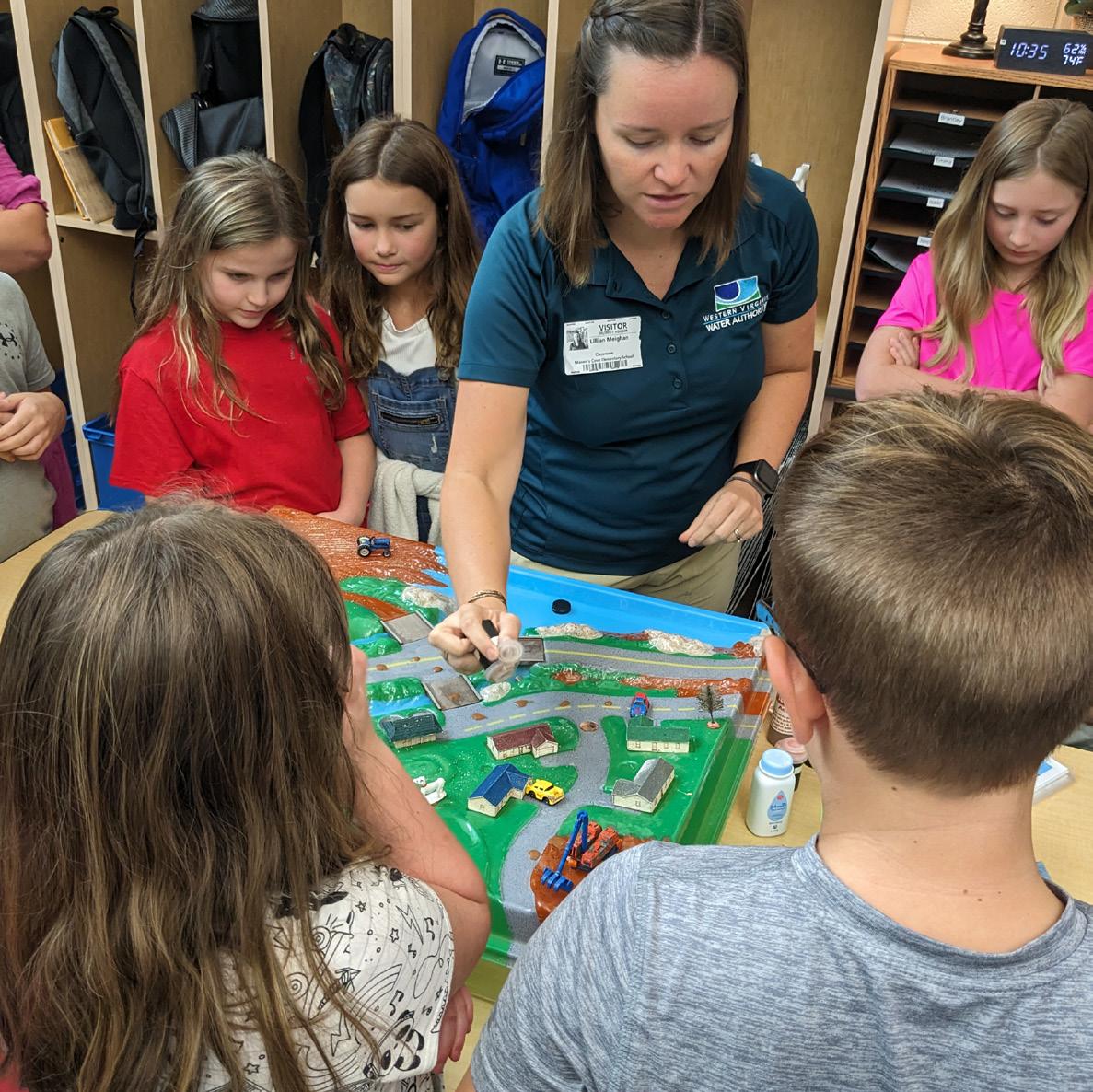
Videos
Learn about our water and wastewater treatment processes or explore the science of water without ever leaving your classroom or home. The Water Authority has a collection of videos on our YouTube channel to teach, inspire and amaze. Visit the Western Virginia Water Authority YouTube channel to start exploring.
